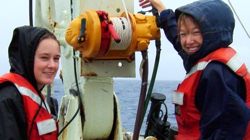Ocean storms create oases in watery desert
Research shows that mid-ocean eddies pump up nutrients to fuel plankton blooms
For two decades, scientists have puzzled over why vast blooms of microscopic plant life form in the middle of otherwise barren mid-ocean regions. In this week's issue of Science, a team including researchers from the Virginia Institute of Marine Science reports that episodic, swirling current systems known as eddies act to pump nutrients up from the deep ocean to fuel such blooms.
The report presents the findings of the EDDIES project, a multi-year study of eddies in the Atlantic Ocean. The project is led by Dennis McGillicuddy of the Woods Hole Oceanographic Institution (WHOI),and includes VIMS Associate Professor Deborah Steinberg, post-doctoral researcher Sarah Goldthwait, graduate student Bethany Eden, and research technician Joe Cope.
Members of the EDDIES team found that ocean productivity was surprisingly high when stirred by certain types of mid-ocean eddies. These huge swirls of water were teeming with diatoms (a type of phytoplankton) in concentrations 10,000 to 100,000 times the norm—among the highest ever observed in the Sargasso Sea, an otherwise barren mid-ocean region south of Bermuda.
McGillicuddy notes that "Past research has shown that the open ocean is far more productive than we could explain based on what we knew about nutrients in the water. Scientists have been trying to figure out where the nutrients come from to make these oases in the oceanic desert, and some of us hypothesized that eddies were part of the answer. The EDDIES project has validated that suspicion."
The Sargasso Sea, like other mid-ocean regions of the world, is warmer, saltier, bluer, and clearer than most other parts of the North Atlantic. Prevailing oceanographic wisdom has suggested that such open waters were mostly desert-like, unproductive regions populated by a few smaller plant species. Yet observations showed oxygen and other biologically important elements were being consumed at a higher rate than theories and models predicted. There had to be some natural nutrient source.
The EDDIES team found that eddies draw nutrients from the deep, thereby fertilizing surface waters and priming the ocean's "biological pump." Fed by this unusual upwelling, the phytoplankton population explodes. Steinberg's team found that this in turn attracts more zooplankton, small drifting animals that feed on the phytoplankton within the eddies.

"Eddies have a dramatic ripple effect on the open-ocean food web," says Steinberg. Her team found up to three times as much zooplankton within eddies as they did in surrounding waters.
They also discovered that the end result of this souped-up food web is a significant increase in the number of fecal pellets—zooplankton poop—sinking out of the eddies' surface waters toward the seafloor.
"Fecal pellets are heavier than phytoplankton cells and sink faster, thus making a more efficient biological pump," says Steinberg. "They're a more efficient way to get carbon to the deep ocean."
Pumping carbon to the deep ocean is important because it allows the ocean surface to soak up more carbon dioxide from the air, thus lowering the concentration of this greenhouse gas in the atmosphere. Carbon dioxide that is pumped to the deep ocean can remain there for thousands of years, contributing nothing to global warming.
In addition to WHOI and VIMS, the EDDIES team included scientists from the Bermuda Institute of Ocean Sciences (BIOS), Rutgers University, the University of Southampton (UK), the University of California-Santa Barbara, Humboldt State University, and the University of Miami.
In nearly six months of ship-based work in the summers of 2004 and 2005, the researchers employed a combination of remote sensing, video plankton recorders, electronic plankton nets, ocean drifters, tracers, and traditional measurements of water properties and current speeds.
They started with NASA satellite measurements of sea-surface height to locate eddies in the Sargasso Sea, south and east of the Gulf Stream in the North Atlantic. The 18-member research team then sailed into those eddies with the research vessels Oceanus (operated by WHOI) and Weatherbird II (operated by BIOS).
—by Stephanie Murphy of WHOI; adapted by David Malmquist of VIMS

